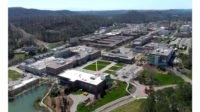They’ve been around for decades, but geothermal heating and cooling systems are now poised to meet the moment.
Geothermal manufacturers at the recent AHR Expo in Atlanta reported growing interest in their products, which fit well with the movements toward building decarbonization, electrification, and automation.
Though the systems can cost several times more than traditional HVAC, the energy savings are substantial; the Environmental Protection Agency (EPA) considers geothermal energy a renewable energy source, and the Department of Energy (DOE) estimates their energy savings can recoup the extra cost of a system in five to 10 years, depending on the price of energy and the available incentives. And with the introduction of new incentives in the Inflation Reduction Act (IRA), the out-of-pocket price of geothermal is coming down for many.
Here’s a look at products from three geothermal companies that exhibited at this year’s Expo.
ClimateMaster
At the AHR exhibit for ClimateMaster, which is based in Oklahoma, senior marketing sustainability manager Joe Parsons talked up the flexible, space-saving qualities of the Tranquility Low Profile (TRL) series of water-to-air heat pumps for commercial and multifamily buildings. The units all have a 9-inch cabinet height and can be installed in ceiling spaces with as little as a foot of vertical space.

UNOBTRUSIVE: A ClimateMaster Tranquility Low Profile (TRL) water-to-air heat pump, designed for commercial and multifamily buildings. The units have a 9-inch cabinet height and can be installed in ceiling spaces with as little as a foot of vertical space. (Staff photo)
“It’s a huge advantage in terms of the amount of space it takes up,” Parsons said.
TRL heat pumps are available in sizes ranging from a half-ton to 1.25 tons, and come with a variable-speed fan motor for lower electricity consumption, as well as a double-isolation compressor mounting for quieter operation. Options include a flow regulator that limits water flow to prevent over-pumping, ClimateMaster’s Ultra-Quiet sound attenuation package, and a 2-inch filter frame to support advanced air filtration.
ClimateMaster’s iGate2, now available for the TRL series, monitors unit performance and notifies the contractor before a system failure, Parsons said. IGate2 helps contractors with startup, commissioning, and servicing. Plus, “it speaks to the homeowner in plain English, basically,” Parsons said.
“This real-time remote diagnostics and system adjustment capability saves the servicing contractor time and money and provides the end user with peace of mind that their system is operating at optimal performance levels,” Parsons said in an email.
Parsons said the IRA’s incentives are an important step in making geothermal systems more affordable for homeowners.
“It’s an extremely advantageous time for geothermal,” he said.
Enertech
Enertech Global LLC, an Illinois-based maker of geothermal and air-source heat pumps, was showing off its EnerSketch Pro, a design, pricing, and sales platform for geothermal systems. EnerSketch Pro was developed by Rob Derksen, an Enertech business development manager and the owner of D4 Consulting.
EnerSketch Pro allows for system customization, proposal generation, and even order placement. The software “can help make the contractor’s life much easier” and result in “a more professional proposal and an opportunity to get the proposal back in the consumer’s hands much quicker,” said Tim Wright, Enertech’s chief strategy officer.
Wright also touted the Enertech Performance InterConnection (EPIC) controls, a geothermal system monitoring technology for homeowners and contractors.
“More and more people want connected controls,” said Wright.
EPIC provides protected access to a system, temperature set-point control, and real-time diagnostic capabilities. With the latter function, contractors can alert homeowners to potential system issues before they occur, solve some problems remotely, and learn what needs to be done to solve others before sending out a technician.
“They already know what the problem is before they ever come to the home,” Wright said.
Wright said Enertech is seeing greater demand for geothermal systems in housing and mixed-use developments, especially with the incentives available through the Inflation Reduction Act.
“Developers are looking at a much stronger ROI and now we have the (incentive) longevity required for them to know that their development can be completed while under the IRA tax credit for 10-plus years,” Wright said.
WaterFurnace
Remote system oversight was also a big topic at the WaterFurnace exhibit, where the company displayed an interactive map of the U.S. showing thousands of geothermal systems that feature its Symphony technology.

MOD SQUAD: The WaterFurnace TruClimate is a screw chiller with a small footprint and a modular design that can be used in banks of up to 10 chillers. (Staff photo)
The latest version, Symphony 3.0, is a Wi-Fi-enabled platform for advanced diagnostics and system controls, and includes improved data access and downloadable reports. Symphony allows users to monitor and control WaterFurnace geothermal systems from anywhere through an internet-connected device, and gives technicians access to more system data and diagnostics that help them maintain and repair systems faster, according to a company press release.
WaterFurnace, based in Indiana, has technology that also provides a precise measure of the energy use of a given system.
“A lot of other energy-monitoring solutions take estimates based off of, ‘Well, it ran this long and this is the average of how much it uses.’ But we actually measure it with true data,” said Tim Litton, director of marketing communications at WaterFurnace.
“So our unit is now able to communicate true energy usage,” Litton continued. “On top of that, though, now we can see as an aggregate across the country, how much are people paying in general. So nationwide, the average cost to heat and cool a geothermal home is only $40” a month, he said.
WaterFurnace also had on display a 140-ton model of its TruClimate 700 screw chiller for commercial use, which can be banked with up to nine others. The 700 model has a modular design with a small footprint.
“All of the units that you see here can be walked through a 36-inch standard doorway, which is kind of our claim to fame,” Litton said.








